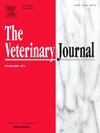The predictive ability of blood-based biomarkers to detect bacteremia in hospitalized neonatal foals
IF 3.1
2区 农林科学
Q1 VETERINARY SCIENCES
引用次数: 0
Abstract
Early and accurate identification of septicemia in neonatal foals improves survival. In human medicine, the neutrophil-to-lymphocyte ratio (NLR), neutrophil-to-monocyte ratio (NMR), monocyte-to-lymphocyte ratio (MLR), and plasma cell-free DNA (cfDNA) aid in early bacteremia detection. This study evaluated the diagnostic utility of these markers in conjunction with other clinical and hematological parameters in hospitalized foals < 5 days old to predict positive blood culture at admission and to distinguish between Gram-positive, Gram-negative, or polymicrobial bacteremia. A total of 391 foals with a complete blood count and aseptically obtained blood culture at admission were included. Physical exam and hematologic parameters, including white blood cell count (WBC) and immunoglobulin G (IgG), were incorporated into logistic regression models, with the area under the curve (AUC) used to assess predictive performance. Plasma cfDNA was measured via fluorometry. We found that plasma cfDNA, IgG, NLR, and WBC were independent predictors of bacteremia, and a composite model demonstrated excellent discriminatory ability to identify foals with a positive blood culture (AUC = 0.806). Additionally, plasma cfDNA, IgG, and neutrophil counts were independent predictors of Gram-negative bacteremia, and a composite model demonstrated excellent discrimination (AUC = 0.807), and monocyte count and age predicted Gram-positive bacteremia with a composite model that demonstrated fair discriminatory ability (AUC = 0.67). Our findings demonstrate that NLR and plasma cfDNA are significantly altered in bacteremic foals. whereas the NMR and MLR do not differ significantly between groups. Combining these markers with other clinicopathologic variables may enable early identification and timely intervention in affected foals.
基于血液的生物标志物检测住院新生马驹菌血症的预测能力
早期和准确识别败血症的新生马驹提高生存率。在人类医学中,中性粒细胞与淋巴细胞比值(NLR)、中性粒细胞与单核细胞比值(NMR)、单核细胞与淋巴细胞比值(MLR)和无浆细胞DNA (cfDNA)有助于早期检测菌血症。本研究评估了这些标志物与住院马驹( 5天)的其他临床和血液学参数的诊断效用,以预测入院时血培养阳性,并区分革兰氏阳性、革兰氏阴性或多微生物菌血症。共有391匹马驹在入院时进行全血细胞计数和无菌血培养。体检和血液学参数,包括白细胞计数(WBC)和免疫球蛋白G (IgG),纳入logistic回归模型,曲线下面积(AUC)用于评估预测效果。用荧光法测定血浆cfDNA。我们发现血浆cfDNA、IgG、NLR和WBC是菌血症的独立预测因子,复合模型显示出良好的鉴别能力,可以识别出血培养阳性的马驹(AUC = 0.806)。此外,血浆cfDNA、IgG和中性粒细胞计数是革兰氏阴性菌血症的独立预测因子,复合模型具有良好的鉴别能力(AUC = 0.807),单核细胞计数和年龄预测革兰氏阳性菌血症的复合模型具有良好的鉴别能力(AUC = 0.67)。我们的研究结果表明,NLR和血浆cfDNA在菌血症马驹中显着改变。而NMR和MLR在两组之间没有显著差异。将这些标记物与其他临床病理变量相结合,可以早期识别和及时干预受影响的马驹。
本文章由计算机程序翻译,如有差异,请以英文原文为准。
求助全文
约1分钟内获得全文
求助全文
来源期刊

Veterinary journal
农林科学-兽医学
CiteScore
4.10
自引率
4.50%
发文量
79
审稿时长
40 days
期刊介绍:
The Veterinary Journal (established 1875) publishes worldwide contributions on all aspects of veterinary science and its related subjects. It provides regular book reviews and a short communications section. The journal regularly commissions topical reviews and commentaries on features of major importance. Research areas include infectious diseases, applied biochemistry, parasitology, endocrinology, microbiology, immunology, pathology, pharmacology, physiology, molecular biology, immunogenetics, surgery, ophthalmology, dermatology and oncology.
 求助内容:
求助内容: 应助结果提醒方式:
应助结果提醒方式:


